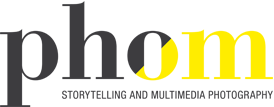Uno dei casi editoriali del 2014, e vincitore dell'Author Book Award ai Rencontres d'Arles, Hidden Islam è il risultato di una felice fusione di fattori: un progetto fotografico chiaro, grande cura editoriale, e un'attenzione mediatica superiore a quella comunemente riservata all'editoria fotografica. Lo abbiamo sfogliato per voi.
La struttura di Hidden Islam, rispecchia in tutto il concetto che vi sta dietro: il disvelamento.
A causa di motivi diversi, le comunità islamiche residenti nel nord-est utilizzano per la preghiera spazi inizialmente - o contestualmente - destinati ad altro: palestre, case private, capannoni, magazzini. Edifici comuni, indistinguibili dall'esterno - nessun minareto - spesso in zone periferiche di città e paesi, che il venerdì si trasformano, e accolgono i fedeli delle diverse comunità.
Ed ecco il disvelamento: le foto in bianco e nero, di rigorosa semplicità e "anonime" come gli edifici che mostrano, nascondono una realtà diversa, a colori, sotto le pagine pieghevoli. Sono le foto degli interni, illuminati spesso dai neon, e delle pratiche di comunità che dentro vi avvengono: preghiera, certamente, ma anche incontri e discussioni. Sullo sfondo, le tracce della vita diurna dell'edificio ospite: sponsor di eventi sportivi, quadri elettrici, arredi scolastici... Un libro semplice e rivelatore - discussioni annesse.
Pubblicato da Rorhof, introduzione di Martin Parr. 90 pagine con 45 pagine pieghevoli, copertina rigida, 16x24cm. 2014.
Gabriele Magazzù
ENGLISH VERSION
One of the editorial hits of 2014 and winner of the Rencontres d’Arles Author Book Award, Hidden Islam is the result of a fusion of factors: a clear photographic project, great editorial eye and above-the-average media attention. We have browsed through it for you.
Hidden Islam’s structure fully reflects the concept that sustains it: the process of unveiling. Because of a myriad of reasons, the Islamic communities of North-Eastern Italy are accustomed to pray in locations that are initially or simultaneously destined to other aims. Gyms, private households, warehouses and garages - common buildings that can’t be recognized from the outside (there are no minarets), and located on the outskirts of cities and towns that transform every Friday to welcome the believers.
And this is when the unveiling takes place: the black and white photos, whose rigorous simplicity recalls the sense of “anonymity” of the buildings, hide a different reality underneath the folding pages - in color. It’s the photos of the interiors (often lit by neons) and of the practices that take place there - not only prayers, but meeting and debates, too. On the background there are traces of the daily life of the hosting building: sponsors of the sports events, electric pictures, school furniture… It’s a simple and revealing book - discussions included.
Published by Rorhof, introduction by Martin Parr. 90 pages with 45 folding pages, hardcover, 16x24cm. 2014.
The articles here have been translated for free by a native Italian speaker who loves photography and languages. If you come across an unusual expression, or a small error, we ask you to read the passion behind our words and forgive our occasional mistakes. We prefer to risk less than perfect English than limit our blog to Italian readers only.

Leave a Reply